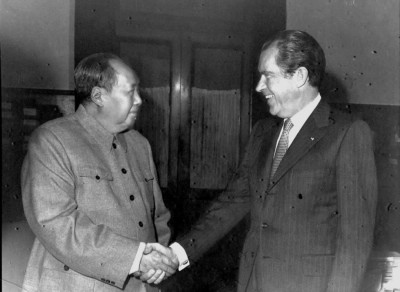
February 21-28, 1972: U.S. President Richard Nixon visited China at the invitation of Chinese Premier Zhou Enlai, with a Sino-U.S. joint communique released in Shanghai on February 28.
February 22, 1973: The two countries announced the establishment of liaison offices.
December 1-5, 1975: U.S. President Gerald Ford visited China.
December 16, 1978: The two countries simultaneously issued a joint communique calling for the establishment of diplomatic relations. The communique said the two countries fully recognized each other and would formally set up diplomatic relations on January 1, 1979.
January 1, 1979: China and the United States officially established diplomatic relations. The U.S. State Department formally notified the Taiwan authorities that the U.S.-Taiwan Mutual Defense Treaty would be terminated on January 1, 1980.
January 28-February 5, 1979: Chinese Vice Premier Deng Xiaoping paid an official visit to the United States at the invitation of U.S. President Jimmy Carter.
February 28, 1979: The United States and Taiwan closed their "embassies."
April 10, 1979: U.S. President Carter signed the Taiwan Relations Act.
December 31, 1979: America terminated the U.S.-Taiwan Mutual Defense Treaty signed in 1954.
August 17, 1982: China and the United States issued a joint communique on gradually reducing and finally resolving the issue of U.S. arms sales to Taiwan.
January 10-16, 1984: Chinese Premier Zhao Ziyang visited the United States.
April 26-May 1, 1984: U.S. President Ronald Reagan visited China.
July 22-31, 1985: Chinese President Li Xiannian visited the United States.
February 24-27, 1989: U.S. President George H.W. Bush visited China.
October 2, 1989: Chinese Vice Premier Qian Qichen offered four suggestions for improving Sino-U.S. relations.
June 1991: America announced three sanctions on China—suspending exports of satellites and related components, restricting exports of high-speed computers and prohibiting exports of missile-related products to some Chinese companies.
November 19, 1993: Chinese President Jiang Zemin met with U.S. President Bill Clinton in Seattle during an informal meeting of APEC leaders.
May 26, 1994: U.S. President Clinton announced the extension of the most-favored nation (MFN) trade status to China, along with a decision to delink MFN from human rights issues.
November 14, 1994: Jiang and Clinton met in Indonesia during an informal meeting of APEC leaders.
October 24, 1995: Jiang met with Clinton while the Chinese leader was attending activities marking the 50th anniversary of the establishment of the United Nations.
November 24, 1996: Jiang met Clinton in the Philippines during an informal meeting of APEC leaders.
May 19, 1997: Clinton announced the decision to extend China's MFN status for another year.
October 26-November 2, 1997: President Jiang Zemin paid a state visit to the United States.
April 6-14, 1999: Premier Zhu Rongji made an official visit to America.
March 2001: Vice Premier Qian Qichen visited America.
Feb. 20-21, 2002: U.S. President George W. Bush visited China.
April 27-May 3, 2002: Vice President Hu Jintao visited America.
December 2003: Premier Wen Jiabao paid an official visit to the United States and stated five principles to maintain a healthy and sustainable Sino-U.S. economic and trade relationship, which were backed by President Bush.
August 1, 2005: Chinese Vice Foreign Minister Dai Bingguo and U.S. Deputy Secretary of State Robert Zoellick held the first Sino-U.S. strategic dialogue in Beijing.
September 13, 2005: Chinese President Hu Jintao and U.S. President George W. Bush met on the 60th anniversary of the establishment of the United Nations, stating that the two countries would promote mutual trust and develop their constructive cooperative relationship.
November 8, 2005: China and the United States signed a memorandum of understanding on textile and clothing trade in London.
November 19-21, 2005: U.S. President George W. Bush paid an official visit to China.
December 7-8, 2005: The second Sino-U.S. strategic dialogue was held in the United States.
April 18-21, 2006: Chinese President Hu Jintao paid a state visit to the United States. In his speech entitled Promoting the All-Around Constructive and Cooperative China-U.S. Relationship, Hu offered a six-point proposal on Sino-U.S. ties.
November 8, 2006: The third Sino-U.S. strategic dialogue was held in Beijing.
December 14-15, 2006: China-U.S. Strategic Economic Dialogue debuted.
|
The Three Communiques
—The Shanghai Communique (signed on February 27, 1972)
In the communique, China and the United States acknowledge essential differences in their social systems and foreign policies. However, the two sides agreed that countries, regardless of their social systems, should conduct their relations on the principles of respect for the sovereignty and territorial integrity of all states, non-aggression against other states, non-interference in the internal affairs of other states, equality and mutual benefit, and peaceful coexistence. International disputes should be settled on this basis, without resorting to the use or threat of force. China and the United States are prepared to apply these principles to their mutual relations.
—Joint Communique on the Establishment of Diplomatic Relations Between the United States of America and the People's Republic of China (released on December 15, 1978)
According to the communique, China and the United States have agreed to recognize each other and to establish diplomatic relations as of January 1, 1979, and exchange ambassadors and establish embassies on March 1, 1979.
Besides, America recognizes the Government of the People's Republic of China as the sole legal government of China. Within this context, the people of the United States will maintain cultural, commercial, and other unofficial relations with the people of Taiwan.
—Sino-U.S. Joint Communique (issued on August 17, 1982)
In this communique, the U.S. Government attaches great importance to its relations with China, and reiterates that it has no intention of infringing on Chinese sovereignty and territorial integrity, or interfering in China's internal affairs, or pursuing a policy of "two Chinas" or "one China, one Taiwan." The U.S. Government understands and appreciates the Chinese policy of striving for a peaceful resolution of the Taiwan issue as indicated in China's Message to Compatriots in Taiwan issued on January 1, 1979, and the Nine-Point Proposal put forward by China on September 30, 1981. |
| 